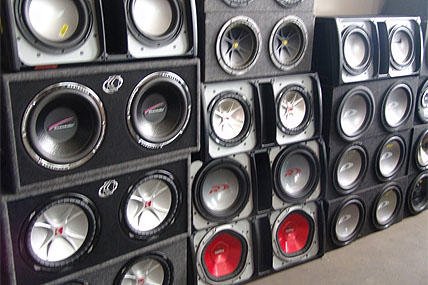It's not uncommon to start out with grand expectations when fantasizing about your future car audio system. It's nice to dream, and it's free! But when it's time to come down to reality, you'll need to accurately assess your car, your needs, and your budget to determine what works best for you.
Your car
Although you may want a wall of 18-inch subwoofers that will blow away the boys (and girls) down at the local hang site, if you're driving a Ford Focus, such a scenario is obviously unrealistic. Even if you drive a large SUV, you probably can't fill it up with bulky amplifiers and subwoofers if you use it to transport stuff like kids, groceries, or tools for your work.
Tip: You'll also need to consider how long you plan to keep your car. If it's yours for life, you can probably go crazy and turn it into the ultimate sound machine. But if you plan to trade it in or sell it in a few years, keep in mind that prospective buyers may not be as thrilled as you are about the custom car audio system. In fact, contrary to what you may think, a mega sound system sometimes detracts from the value of a vehicle.
Warning: This is especially true of cars that are traded in at the dealer level. The last thing they want to see is a bunch of non-factory authorized accessories "hanging off of a vehicle," as one auto insider once told me. Consequently, you'll take a big hit on the value. And if you're driving a leased vehicle, you'll want to tread very lightly when adding car audio components or any accessories that may alter the car. Otherwise, you could be hit with a penalty at lease end.
Your needs
Have you ever bought something and went with all the bells and whistles and later found out that you don't need them all? Shopping for a car audio system is not much different. You'll want to make sure you get what you need and aren't buying stuff you don't. Although a car's physical space will dictate how much car audio equipment you can install in it, your appetite for the latest and greatest doesn't have such built-in limitations. Consequently, it can sometimes be difficult not to go overboard and overspend on items and features you don't need or will never use.
Tip: Think about your listening habits and media preferences as well as your own aesthetics preferences. For example, although it may be cool to buy a head unit with a display that offers 1,000 different colors, is it really worth the extra money you may spend? Or will a subwoofer with lights that blink to the beat really add anything in terms of sound quality -- or improve your image on the street? These are questions only you can answer, and you should ask.
Your budget
I like to think of a budget as a self-correcting system. Although anyone can come up with an awesome car audio system on paper -- and many enthusiasts both experienced and inexperienced often do -- when it comes down to plunking down your cash, writing a check, or whipping out your credit card, the reality of your financial situation takes over.
Tip: Therefore, it's essential to take stock of what you can afford and plan accordingly. One of the great things about car audio is you don't have to buy everything at once and you can add on to your system as funds become available. You can start off with a head unit, for example, that powers the factory speakers, and then add aftermarket speakers later on. After that, you can add an amplifier and maybe a subwoofer.
If you do splurge and go for the whole system at once, it's important to allocate your money wisely. For example, you don't want to blow your wad on a super-duper head unit and then skimp on the amplifiers and speakers if you later have to replace them. That's counterproductive and wasteful.
Although there's no magic formula on how to spread a given amount of funds on a car audio system, here's a general guideline on the percentage you should allocate to a given area:
- Amplifier(s): 40%
- Speakers: 30%
- Head unit: 20%
- Accessories: 10%
Use this as a general guideline when you start planning your component-buying budget, but take it with a few grains of salt. You may, for example, decide to spend more on a high-end head unit and less on amplifiers and speakers.
Remember: If you don't plan to install your system yourself -- and the fact that you're reading this should indicate that you probably will not -- remember to allot a large percentage of your funds to cover professional installation. Installation generally absorbs up to 40 percent of your overall budget, so adjust your planning accordingly.
Warning: I've heard too many stories of over-eager enthusiasts maxing out their credit cards and damaging their credit ratings to get a car audio system they couldn't otherwise afford. As badly as you may want a system for your ride, think long-term and don't do anything stupid. You can add to your system as you have the dough, and many reputable independent car audio shops will work with you if they know you're in it for the long haul and will be back to buy more. They may even cut you a great deal on used or discontinued equipment. So before you go into debt to get that system, think about whether its worth it in the long run.
From Car Audio for Dummies, copyright © 2008 by John Wiley & Sons, Inc., Hoboken, New Jersey. Used by arrangement with John Wiley & Sons, Inc.










